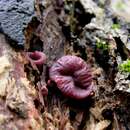en
names in breadcrumbs


Helotiales is an order of the class Leotiomycetes within the division Ascomycota.[1] The taxonomy within Helotiales has been debated. It has expanded significantly as genomic techniques for taxonomical identification have become more commonly used. As of February 2020, the order is estimated to contain 30 accepted families, 519 genera, and 6266 species.[2]
Helotiales is the largest order of non-stromatic discomycetes that usually, but not always, have brightly coloured apothecia. Many members of the family have obviously cup-shaped ascomata with little or no stipes. They are usually found fruiting on coarse or large wood debris as well as on other organic matter. Part of these discomycetes are limited to a specific host range, this goes as far as to not just being limited to one particular plant, additionally some species need a particular part of that plant.[3]
Green Elfcup or Green Wood Cup Chlorociboria aeruginascens, family: Chlorociboriaceae
(photo: Holger Krisp)
Ascocoryne, family: Helotiaceae
Mollisia benesuada, family: Dermateaceae
Bisporella citrina, family: Helotiaceae
Arachnopeziza aurata, family: Hyaloscyphaceae
Brown oak disk cup Rutstroemia firma, family: Rutstroemiaceae
(photo: Holger Krisp)
The necrotrophic fungus Botrytis conidiophores, Magnification X16 , family: Sclerotinaceae
Vibrissea truncorum, family: Vibrisseaceae
image source: Mushroom Observer[13]
{{cite web}}: CS1 maint: url-status (link) {{cite web}}: CS1 maint: url-status (link) Helotiales is an order of the class Leotiomycetes within the division Ascomycota. The taxonomy within Helotiales has been debated. It has expanded significantly as genomic techniques for taxonomical identification have become more commonly used. As of February 2020, the order is estimated to contain 30 accepted families, 519 genera, and 6266 species.
Helotiales is the largest order of non-stromatic discomycetes that usually, but not always, have brightly coloured apothecia. Many members of the family have obviously cup-shaped ascomata with little or no stipes. They are usually found fruiting on coarse or large wood debris as well as on other organic matter. Part of these discomycetes are limited to a specific host range, this goes as far as to not just being limited to one particular plant, additionally some species need a particular part of that plant.